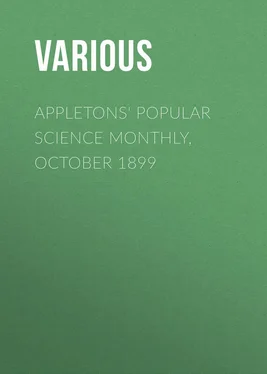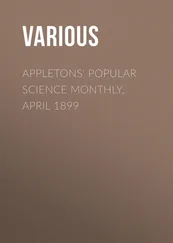Various - Appletons' Popular Science Monthly, October 1899
Здесь есть возможность читать онлайн «Various - Appletons' Popular Science Monthly, October 1899» — ознакомительный отрывок электронной книги совершенно бесплатно, а после прочтения отрывка купить полную версию. В некоторых случаях можно слушать аудио, скачать через торрент в формате fb2 и присутствует краткое содержание. Издательство: Иностранный паблик, Жанр: periodic, foreign_edu, на английском языке. Описание произведения, (предисловие) а так же отзывы посетителей доступны на портале библиотеки ЛибКат.
- Название:Appletons' Popular Science Monthly, October 1899
- Автор:
- Издательство:Иностранный паблик
- Жанр:
- Год:неизвестен
- ISBN:нет данных
- Рейтинг книги:3 / 5. Голосов: 1
-
Избранное:Добавить в избранное
- Отзывы:
-
Ваша оценка:
- 60
- 1
- 2
- 3
- 4
- 5
Appletons' Popular Science Monthly, October 1899: краткое содержание, описание и аннотация
Предлагаем к чтению аннотацию, описание, краткое содержание или предисловие (зависит от того, что написал сам автор книги «Appletons' Popular Science Monthly, October 1899»). Если вы не нашли необходимую информацию о книге — напишите в комментариях, мы постараемся отыскать её.
Appletons' Popular Science Monthly, October 1899 — читать онлайн ознакомительный отрывок
Ниже представлен текст книги, разбитый по страницам. Система сохранения места последней прочитанной страницы, позволяет с удобством читать онлайн бесплатно книгу «Appletons' Popular Science Monthly, October 1899», без необходимости каждый раз заново искать на чём Вы остановились. Поставьте закладку, и сможете в любой момент перейти на страницу, на которой закончили чтение.
Интервал:
Закладка:
The roof of a Hopi house is always of interest. Here we may see corn drying in the sun or loads of fagots ready for use, women dressing their hair or fondling their babies, or groups of children playing or roasting melon seeds in an old broken earthenware vessel which rests on stones over a fire. From the projecting rafters are ears of corn hung up to dry, or pieces of meat placed there to be out of reach of the dogs, or bunches of yarn just out of the dye pot. When a ceremony is being performed in some one of the plazas the roofs near by present a scene which is animated in the extreme, every square foot of space being occupied by a merry, good-natured throng of young and old. As one looks from one group to another it is impossible not to notice the stunted and dwarfed appearance of the women, which is in marked contrast to that of the men, who are beautifully formed, of medium height, and of well-knit frames. There is not, however, the same powerful ruggedness or splendid development among these pueblo dwellers which we find among the plains Indians, for the days of the Hopi women are spent in carrying water and grinding corn, while the men in summer till their fields and in winter spin and weave.
In considering the routine life of the Hopi it is hard to draw a sharp line between what we may call his regular daily occupations and his religious life, for they are closely interwoven. He is by nature a religionist, and he never forgets his allegiance and obligations to the unseen forces which control and command him.
In nothing is the primitiveness or the absence from contamination of the Hopi better revealed than in the children, for here, as elsewhere, is it shown that they are the best conservators of the habits and customs of ancestral life. What utter savages the little fellows are! Stark naked generally, whether it be summer or winter, dirty from head to foot, their long black hair disheveled and tangled and standing out in every direction, their head often resembling a thick matted bunch of sagebrush. They are never idle; now back of the village behind tiny stone ramparts eagerly watching their horsehair bird snares, or engaged in a sham battle with slings and corncobs, or grouped in threes or fours about a watermelon, eagerly and with much noise gorging themselves to absolute fullness, or down on the side of the mesa playing in the clay pits. A not uncommon sight is that of two or three little fellows trudging off in pursuit of imaginary game, armed with miniature bows and arrows or with boomerangs and digging-sticks. In their disposition toward white visitors they are extremely shy and reticent, but they are also very inquisitive and curious, and, furthermore, they have a sweet tooth, and one only need display a stick of candy to have half the infantile population of the pueblo at his heels for an hour at a time. If perchance one of the little fellows should die, he is not buried in the common cemetery at the foot of the mesa, but he is laid away among the rocks in some one of the innumerable crevices which are to be found on all sides near the top of the mesa, for the Hopis, in common with many other native tribes of America, believe that the souls of departed children do not journey to the spirit land, but are born again.
As the girls reach the age of ten or twelve they distinguish themselves by dressing their hair in a manner which is both striking and absolutely unique on the face of the earth. The hair is gathered into two rolls on each side of the head, and then, at a distance of from one to two inches, is wound over a large U-shaped piece of wood into two semicircles, both uniting in appearance to form a single large disk, the diameter of which is sometimes as much as eight inches. After marriage the hair is parted in the middle over the entire head, and is gathered into two queues, one on each side, which are then wound innumerable times by a long hair string beginning a few inches from the head and extending about four inches. The ends of the queues are loose. Hopi maidens are, as a rule, possessed of fine, regular features, slender, lithe, and graceful bodies, and are often beautiful. But with the early marriage comes a daily round of drudgery, which prevents full development and stunts and dwarfs the body. But to old age she is generally patient, cheerful, nor does she often complain. Lines produced by toil and labor may show in her face, but rarely those of worry or discontent. Even long before marriage she has not only learned to help her mother in the care of her younger brothers and sisters, but she has already trained her back to meet the requirements of the low-placed corn mills. From her tenth year to her last it has been estimated that every Hopi woman spends on an average three hours out of every twenty-four on her knees stooping over a metate , or corn-grinder, for corn forms about ninety per cent of the vegetable food of the Hopis.
In every house you will find, in a corner, a row of two, three, or four square boxlike compartments or bins of thin slabs of sandstone set on edge. Each bin contains a metate set at an angle with its lower edge slightly below the level of the floor. There is a clear space around each stone to permit of a better disposition of the corn and meal. The texture of the metates is graduated from the first to the last, the final one being capable of grinding the finest meal. Accompanying the metate is a crushing or grinding stone about a foot in length and from three to four inches wide. Its under surface is flat, while its upper surface is convex to a slight extent, so as to permit of its being grasped firmly by the thumb and fingers of both hands. The corn is ground between these two stones, the upper one being worked up and down the metate by a motion of the operator not unlike that of a woman washing clothes on a washboard. The favorite position assumed by the woman while working is to sit on her knees, her toes resting against the wall of the house behind her. Of the many colors of corn used by the Hopis, blue is the most common, and corn of this color is ordinarily employed in the making of bread; other colors, however, are used for the piki consumed in ceremonial feasts.
The stone used by the Oraibians for making piki is from a sandstone quarry near Burro Springs. It is about twenty inches long by fourteen broad, and is three inches thick. The upper surface is first dressed by means of stone picks, and is polished by a hard rubbing-stone, and then finally treated with pitch and other ingredients until its surface is as smooth as glass. It is mounted on its two long edges by upright slabs, so that it stands about ten inches from the level of the floor, the floor itself being usually excavated to a depth of two or three inches beneath the stone. At a height of about four feet above this primitive griddle is a large rectangular hood which is extended above the roof in the form of a chimney made of bottomless pots, one resting on the other. Kneeling in front of the stone and supporting her body with her left arm, the woman coats the stone with the thin batter of corn and water with the fingers of her right hand. After a few seconds' time she lifts the waferlike sheet from the stone and transfers it to a mat which is made for this special purpose. For some time the piki remains soft and pliable, and while in this condition she rolls or folds the sheets according to her custom – some folding, others rolling it. It is a curious sight on the feast days of certain ceremonies to see women gathering from all quarters of the village at an appointed house, each carrying a tray heaped high with rolls of this paper bread.
The Hopis are among the foremost potters in North America, when we take into consideration the fineness of the clays used and the character of the decoration. But in many respects, especially in form, their ware is much inferior to that of the ancient Mexicans and Peruvians. They make pottery to-day as they did hundreds of years ago, but the quality of the work has greatly deteriorated and the earthenware now produced is not to be compared with that found in near-by Hopi ruins. It should be kept in mind, however, that the specimens found in the ancient graves are to a certain extent ceremonial, and consequently better made and more ornate in their decoration than those which were made simply for household purposes. Still, there are a fineness of texture and a delicacy of coloring in the ancient ware which can not now be produced. It is to be noted, also, that the Hopi woman of to-day can not decipher the designs on the earlier pottery, although she often copies them. The demand for earthenware vessels, however, is nearly as great at present as it was in prehistoric days, for you may search the homes of Oraibi for a long time without finding a tin pan or an iron pot. Thus it is that every Hopi woman must be a worker in clay, and one of the occasional sights is that of a woman on her "front porch" surrounded by vessels of all sizes and in varying degrees of completeness. The process of pottery-making is somewhat as follows: After the clay has been worked into a plastic mass she draws out from it a round strip the size of one's finger and about five inches in length. This is coiled flat in the bottom of the tray, and forms the base of the vessel. Other clay strips are kneaded out of the mass, and these are coiled in a gradually increasing spiral, the desired shape and proportion being acquired at the same time, until the vessel has reached its proper height. The sides of the vessel are then thinned down, and both inside and outside are made smooth by means of small bits of gourds and polishing-stones. The vessel is then ready for a coat of wash, after which it is painted and fired. This method of making pottery is not peculiar to the pueblos, but is found among some of the tribes of South America.
Читать дальшеИнтервал:
Закладка:
Похожие книги на «Appletons' Popular Science Monthly, October 1899»
Представляем Вашему вниманию похожие книги на «Appletons' Popular Science Monthly, October 1899» списком для выбора. Мы отобрали схожую по названию и смыслу литературу в надежде предоставить читателям больше вариантов отыскать новые, интересные, ещё непрочитанные произведения.
Обсуждение, отзывы о книге «Appletons' Popular Science Monthly, October 1899» и просто собственные мнения читателей. Оставьте ваши комментарии, напишите, что Вы думаете о произведении, его смысле или главных героях. Укажите что конкретно понравилось, а что нет, и почему Вы так считаете.












